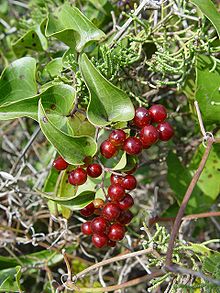| Smilax | |
|---|---|

| |
| Mediterranean smilax (S. aspera) in fruit | |
| Scientific classification | |
| Kingdom: | Plantae |
| Clade: | Tracheophytes |
| Clade: | Angiosperms |
| Clade: | Monocots |
| Order: | Liliales |
| Family: | Smilacaceae |
| Genus: | Smilax L. |
| Type species | |
| Smilax aspera L.
| |
| Species | |
|
About 300–350 (see list) | |
| Synonyms[1] | |
| |
Smilax is a genus of about 300–350 species, found in the tropics and subtropics worldwide.[1] They are climbing flowering plants, many of which are woody and/or thorny, in the monocotyledon family Smilacaceae, native throughout the tropical and subtropical regions of the world. Common names include catbriers, greenbriers, prickly-ivys and smilaxes. Sarsaparilla (also zarzaparrilla, sarsparilla) is a name used specifically for the Neotropical S. ornata as well as a catch-all term in particular for American species. Occasionally, the non-woody species such as the smooth herbaceous greenbrier (S. herbacea) are separated as genus Nemexia; they are commonly known by the rather ambiguous name carrion flowers.
Greenbriers get their scientific name from the Greek myth of Crocus and the nymph Smilax.[2] Though this myth has numerous forms, it always centers around the unfulfilled and tragic love of a mortal man who is turned into a flower, and a woodland nymph who is transformed into a brambly vine.
- ^ a b Kew World Checklist of Selected Plant Families
- ^ Mifsud (2002)